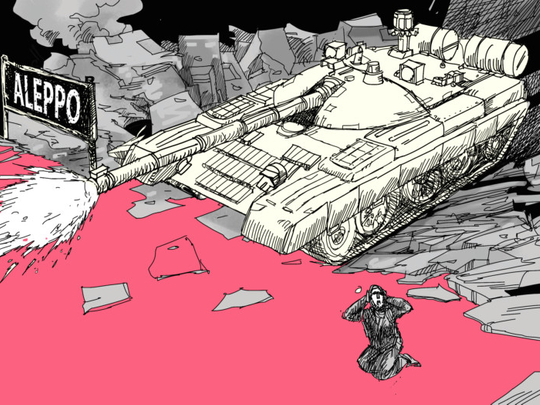
Over the past week, Syrian regime forces, in cooperation with their Iranian and Russian allies, launched a major offensive against the opposition-held areas of Syria’s largest city of Aleppo. A number of factors helped turn the tide against the opposition, which controlled the eastern part of the city since July 2012. Russia provided massive firepower, through its air force, leading to the rapid collapse of opposition defences and paving the way for regime forces and the Iran-backed militia to make major gains on the ground. Moscow’s major goal was to expel opposition forces from the city before the new United States administration assumes power on January 20, 2017, so that its hand would be strengthened in any future negotiations with the US over the future of Syria.
Iran’s military support was also instrumental in changing the balance of power on the ground. Iranian backing, which comes in the form of both regular military forces and militia groups fighting alongside the regime of Syrian President Bashar Al Assad, has made it possible for the Syrian army to compensate for a shortfall in manpower. The preoccupation of the world community, and particularly the US, with the fight against Daesh (the self-proclaimed Islamic State of Iraq and the Levant) has also led to relegating the conflict between the regime and the opposition to the bottom of the world agenda. The vanishing possibility of any direct Turkish military backing for the opposition, in particular since Turkey’s failed coup attempt, contributed also towards weakening the position of the armed Syrian opposition.
While the armed opposition has thus far suffered a major setback by losing Aleppo, the topographical complexity of northern Syria and the high levels of population density in some parts of it mean that the Syrian regime’s ability to hold on to its gains are also open to doubt — notwithstanding massive Russian aerial support. In addition, the regime still does not command the Shuwaihna area that overlooks Aleppo and which remains within firing range of the opposition. In the difficult terrain in which it finds itself, and in a hostile social settings, it would be no surprise if the regime forces fail to secure both their right and left flanks. Equally, the opposition’s ability to launch attacks along the southern rim of the Aleppo Governorate, and in particular on the district of “New Aleppo”, remains intact.
After retaking Aleppo, it is expected that the regime will turn its attention to the towns of East Gouta in the Rif Damascus Governorate. Here the regime continues to attempt to build on its advances since the beginning of July 2016, when it captured the nearby town of Midaa. It also seeks to build on the movement of its troops towards the town of Nashabiyya to which it has laid siege from the south, east and northeast. This greatly increases the risk that the regime will cut supply lines, which tie the opposition forces in those towns to the countryside. One consequence of this situation is that the regime stands a chance of cutting East Gouta into two distinct zones: One in the south, which it controls, and a besieged opposition bastion in the north which, once cut off from the agrarian lands to the south, can be made to kneel through lack of food. In West Gouta, regime forces have been able, with the aid of an unprecedented torrent of barrel bombs, to retake the town of Daraya, which sits right next to the Mezza Air Force base on the outskirt of Damascus.
Most observers predict that the regime is set on plotting a major military campaign, which seeks to capture the town of Harista in Rif Damascus, thereby giving it control of the last remaining opposition outpost on the Damascus-Homs International Highway. If it succeeds, the regime will be able to protect the capital eastern flank from any future attack. Some reports indicate that units within the regime-backed “Nation’s Shield” militia are already in the preparation stages for such a push.
These developments indicate clearly that the regime and its allies have decided to exploit the favourable regional and international conditions to finish off the armed opposition and set the stage for a political solution that would dump United Nations Security Council Resolution 2254, which calls for political transition.
In combination with the latest battlefield developments, this serves to heighten fears that the Syrian opposition is being pushed against a wall, in preparation for a final agreement which ends the conflict but which fails to meet a modicum of the opposition’s demands. That will in fact only serve to prolong one of the ugliest conflict in living human memory.
Dr Marwan Kabalan is a Syrian academic and writer.










